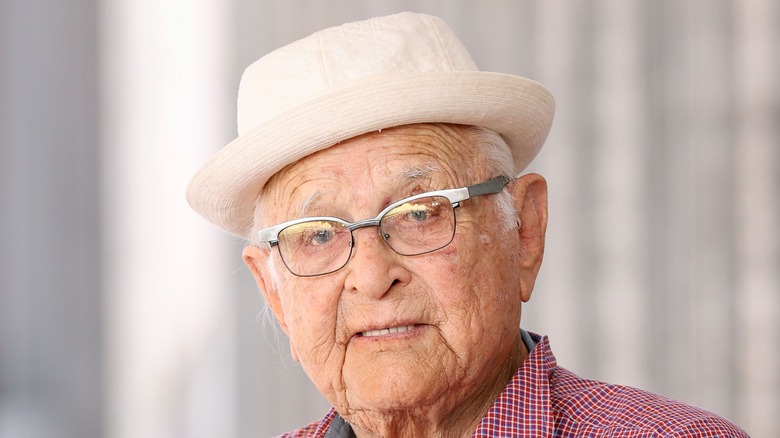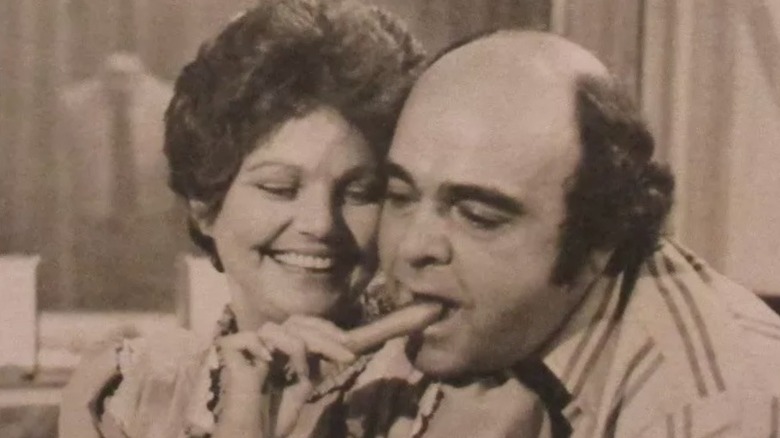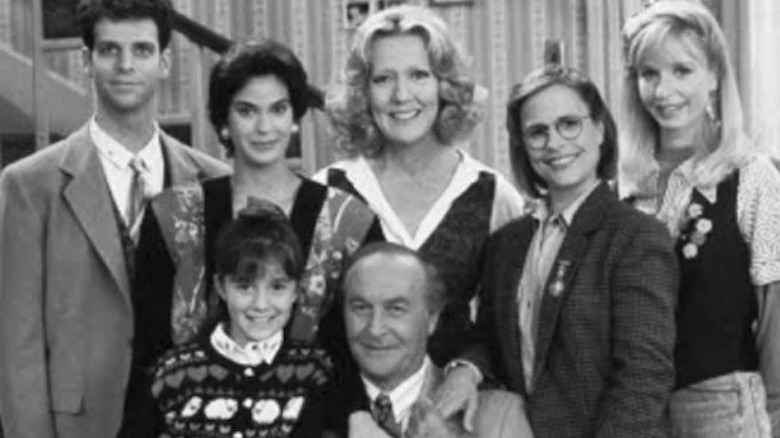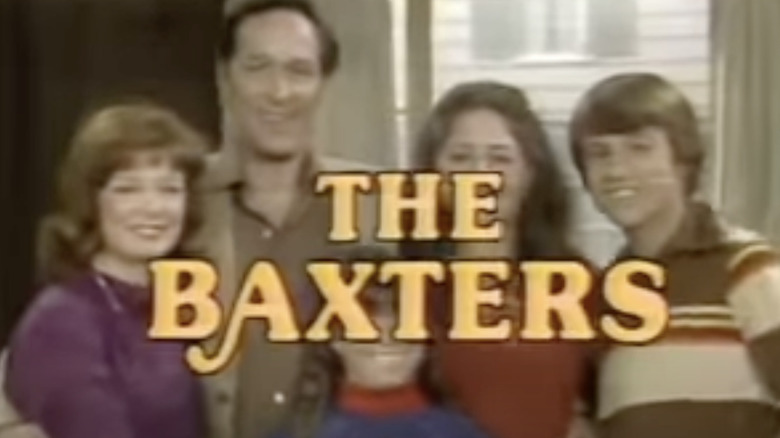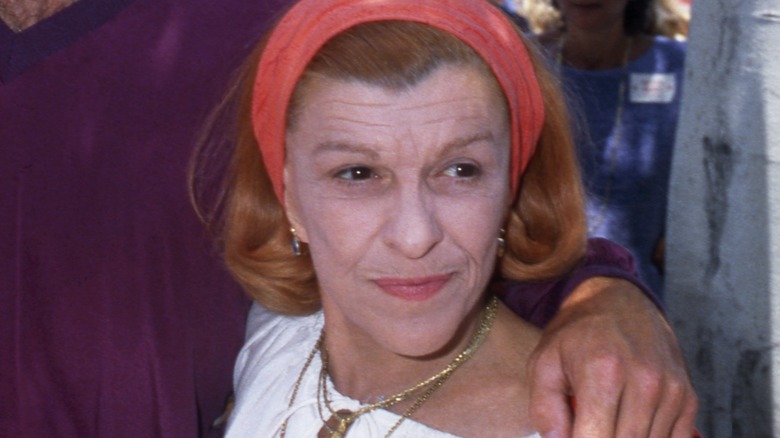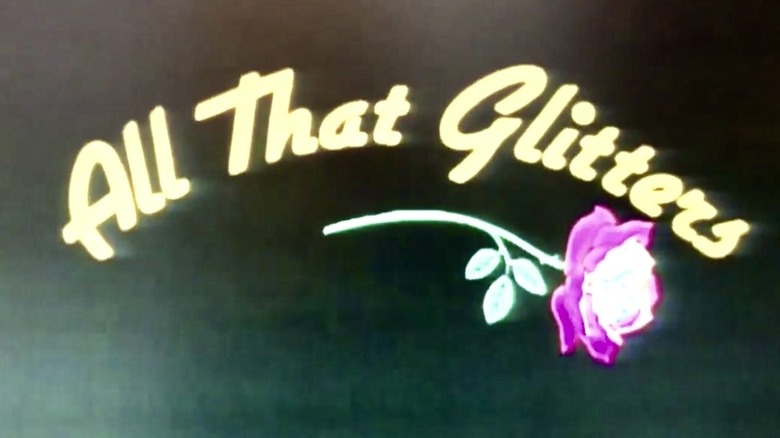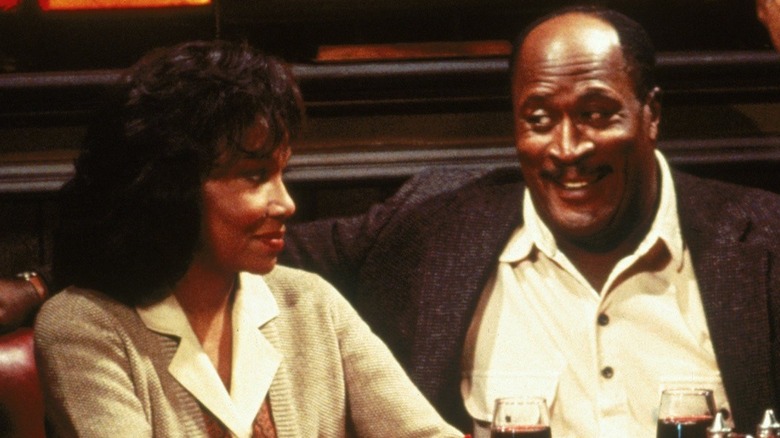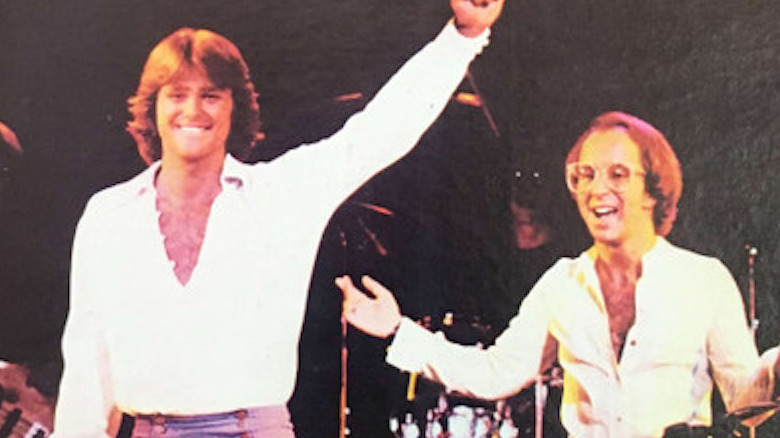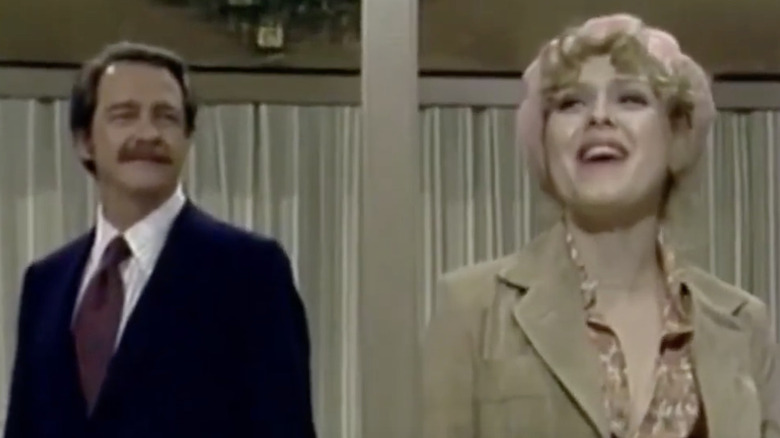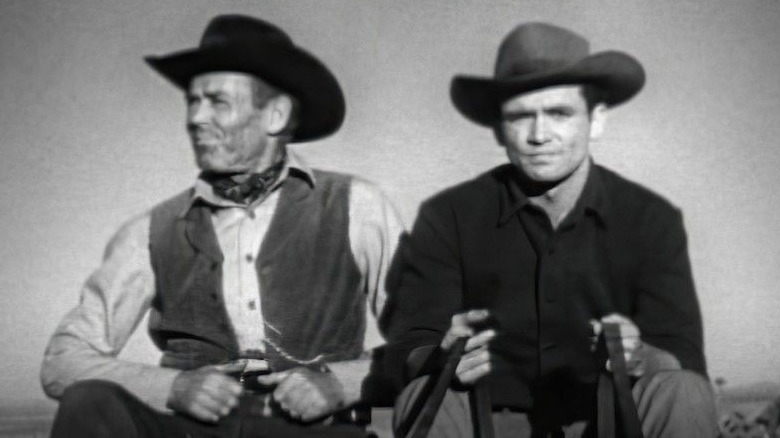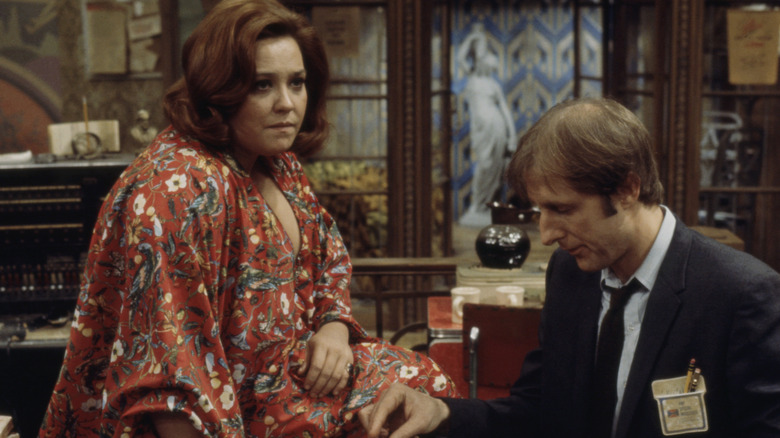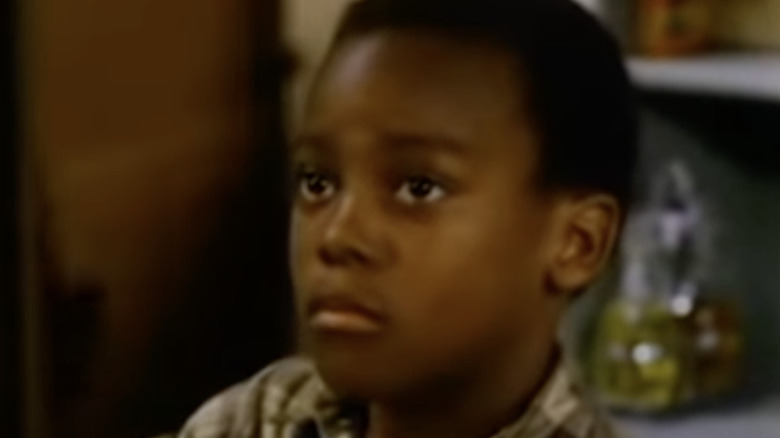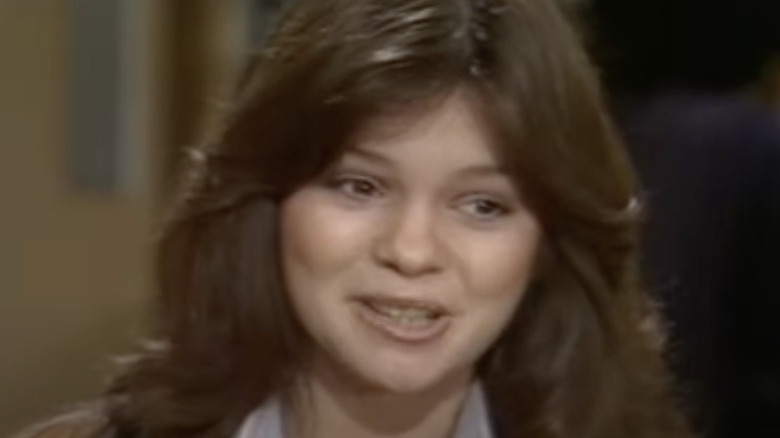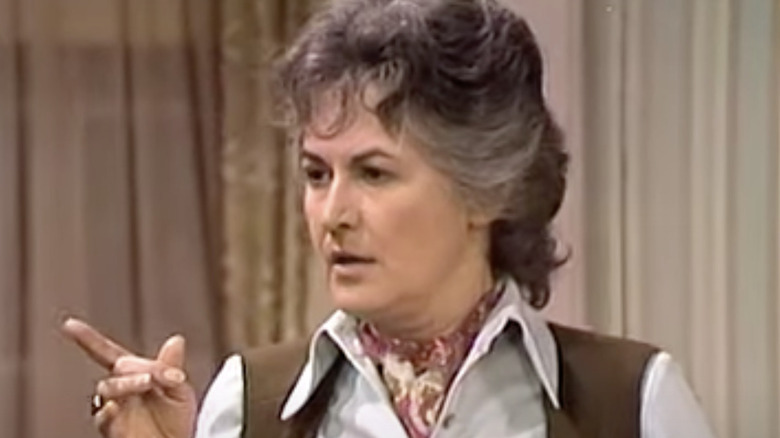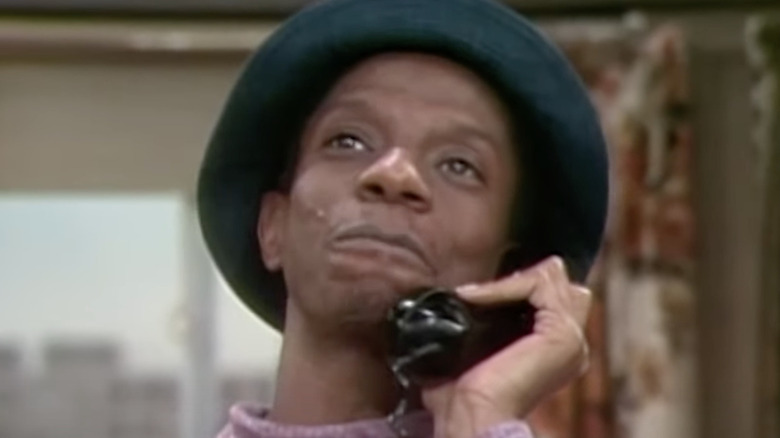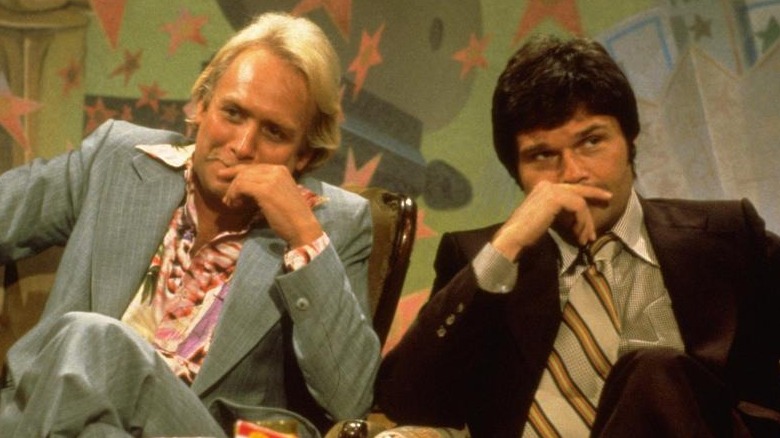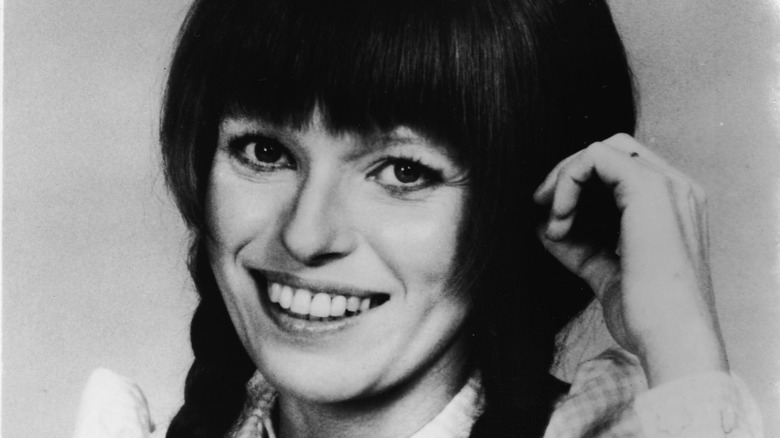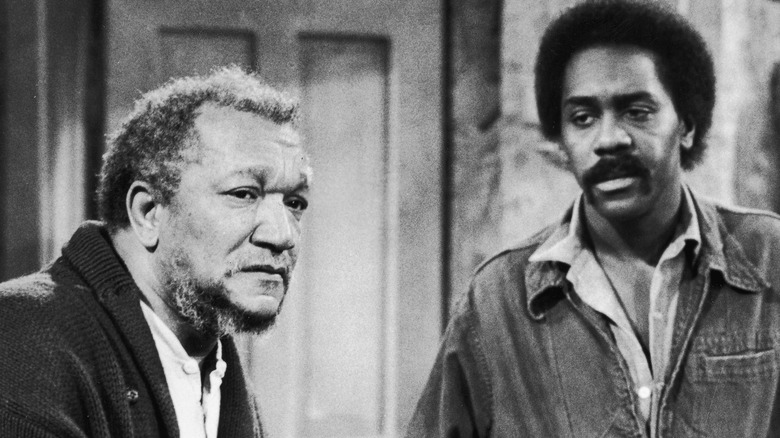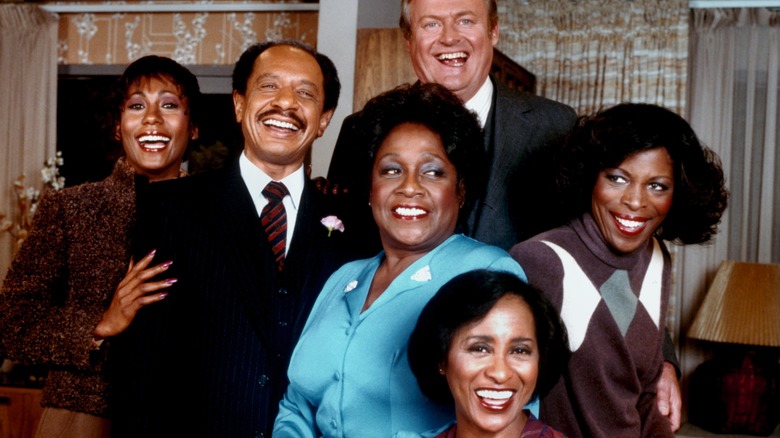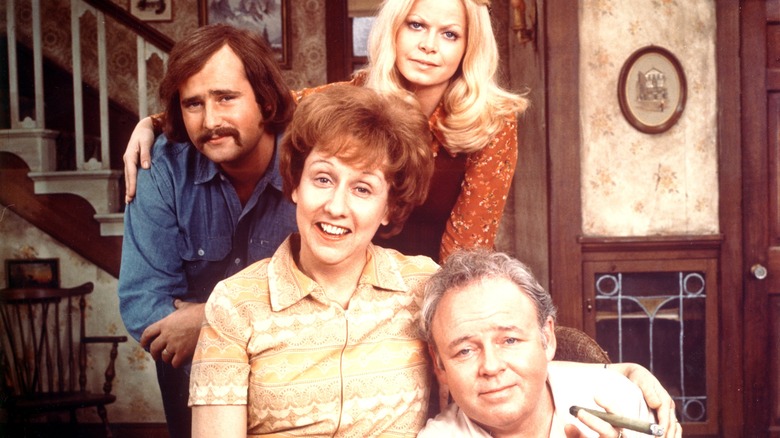Every Norman Lear Show Ranked
This content was paid for by Sony and created by Looper.
Most household names associated with critically acclaimed and commercially successful television shows are the actors. A very small handful of TV writers and creators are well-known to the general public, the kind of artists whose names can be used to brand and market a show because it's so synonymous with quality and a particular kind of thoughtful, progressive, interesting comedy. That pretty much narrows all of TV history down to one person, and that's Norman Lear, a remarkably prolific writer who helped shape and influence television, particularly the ambition, scope, and possibilities of the live in front of a studio audience-type sitcom over a career that's lasted more than seven decades. As of 2022, Lear has created or co-created more than two dozen TV shows. Here's every show that Norman Lear conceived, developed, or actively produced, ranked — from not-best to best.
24. The Dumplings (1976)
By and large, mid-20th-century sitcoms under the Norman Lear brand have aged well because they feature well-rounded, well-written characters behaving and conversing like real people. "The Dumplings" is not one of those shows, because the characters aren't well realized, and because their appearance is not just made fun of, but the basis of the show's premise. Not-thin actors Geraldine Brooks and James Coco star as Angela and Joe Dumpling, a married couple who run a lunch counter in the lobby of a New York office building, and their weight is often a topic of discussion and derision. Sure, they interact with a wide swath of people, from executives to working stiffs to their family members, but there's a lot of overweight jokes (such as the main characters' names) that make "The Dumplings" a hard show to watch in the 21st century.
23. Sunday Dinner (1991)
After a years-long television sabbatical, Norman Lear returned to CBS in 1991 with "Sunday Dinner," a show he created and co-produced. In the way that earlier Lear shows explicitly addressed the issues and how a family can judge its members life choices, so too did Sunday Dinner. It took a stripped-down approach to dramatize weekly meet-ups of the Benedict family, headlined by Ben Benedict, a 56-year-old widower who falls for T.T., two decades his junior, to the chagrin of his sister and spiteful adult daughters. "Sunday Dinner" boasted a familiar Lear approach to social and relationship discussions with a bare bones execution of few sets and few characters, but it didn't quite work for early '90s TV viewers, and it was canceled after six middlingly-received episodes.
22. The Baxters (1979–1981)
Three generations of one family living under one roof, all with different opinions about a rapidly changing world sounds like the perfect, tried and true formula for a Norman Lear show. But "The Baxters" was possibly a little too ambitious. Developed by Lear, but created by Hupert Jessup in Lear's style, "The Baxters" played with the sitcom form. After the plotted, scripted action featuring the Baxter family played out, the show turned into a talk show, where a studio audience would discuss the real social issues faced by the fictional brood. Often retooled with new casts and at new production facilities, the shift of tone seen in "The Baxters" was too novel and too strange from day one.
21. The Nancy Walker Show (1976)
Playing sassy and cankerous older women on "McMillan and Wife" and "Rhoda" made Nancy Walker a breakout TV star in the early 1970s, and Norman Lear co-created a star vehicle for the actor, "The Nancy Walker Show." Despite the solid comic actor at its core, the show felt oddly low-budget, on account of how almost all action took place inside of the luxury apartment of Nancy Kitteridge (Walker), who inconceivably ran a high-end talent agency from her home. Plenty of young and good-looking models and actors were constantly in and out of the show, keeping Nancy company while her Navy commander husband was off at sea. Nancy spent most of her time hanging out with two characters that wound up hard to like: her hypochondriac daughter and a perpetually unemployed actor who was both her client and a boarder. "The Nancy Walker Show" felt like a sitcom from another age, sort of like "I Love Lucy," obsessed with "showbiz" and trading in extra-broad characters.
20. All That Glitters (1977)
After "Mary Hartman, Mary Hartman" (see below) burned brightly and then burned out after two years but more than 300 episodes, co-creator Norman Lear wasn't quite done parodying cheesy and baffling daytime soap operas while also predicting the rise of corporate malfeasance-based primetime soaps like "Dallas." Ultimately, there was so much going on with "All That Glitters" that it was hard to follow. Too clever and too ambitious in pursuing its targets, "All That Glitters" mocked soaps, greedy corporations, and sexism. Set amongst a group of executives at the Globatron Corporation, the show took place in an alternate universe where women, not men, dominated mid-century commerce and the American workplace. All the business types and people in power were women, and all the male characters were receptionists, stay-at-home dads, and objects of lust. "All That Glitters" received poor reviews and lasted 65 daily episodes in syndication.
19. 704 Hauser (1994)
While it had a clever premise, "704 Hauser" suffered from poor execution and paled in comparison to its predecessor and inspiration. The title of the show refers to the Queens home address of Archie and Edith Bunker of Norman Lear's "All in the Family," long since moved out, replaced by John and Rose Cumberbatch. Technically a spinoff of "All in the Family," "704 Hauser" intriguingly reversed the dynamic of the original — conservative white guy bristles at and fights with his progressive daughter — with the Cumberbatches, Black Democrats who butt heads with their conservative son. Featuring discussions ripped from real life at the height of Congressional Republican spats with Democratic president Bill Clinton, "704 Hauser" may have been too hot for TV, and flopped after six episodes.
18. A Year at the Top (1977)
A forgotten sitcom oddity from CBS's late '70s summer schedule starring two TV personalities early in their career, "A Year at the Top" is one of the few fantasy-flavored projects ever undertaken by Norman Lear in his capacity as a producer. Based on the old cautionary tale of selling one's soul to the devil in exchange for worldly success, "A Year at the Top" starred future "My Two Dads" star Greg Evigan and future "The Late Show with David Letterman" bandleader Paul Shaffer as a couple of wannabe rock stars. They trade their immortal souls to the devil's enterprising son for a measly one year as the biggest musical celebrities on the planet. Despite some catchy original songs, "A Year at the Top" didn't last that long, only going a month before CBS killed it, probably on account of how it had a fairly off-putting premise about Satan, not to mention a finite shelf life with no real stakes.
17. All's Fair (1976–1977)
A lot of sitcoms hinge on the hopes that wackiness will ensue by forcing two unlike people into the same situation. It works particularly well when the two characters with next to nothing in common fall in love, giving viewers a weekly amusing analysis of the sometimes utter goofiness that defines a romance. On "All's Fair," co-created by Norman Lear for CBS in the 1976–77 TV season, starred Richard Crenna and Bernadette Peters as a seemingly ill-matched couple — he's a middle-aged conservative newspaper columnist and gourmet, she's a college-aged progressive photographer vegetarian. Can they make it work? Of course they do, although wackiness does ensue.
16. Hanging In (1979)
Due to the circumstances that led to its inception, "Hanging In" could have easily been a messy show with an unclear voice, but by 1979, producer Norman Lear knew how to hang in there as far as TV was concerned. He helped transform what was conceived as spinoff of "Maude" into a clever, insightful, and gently satiric parody of high-level academics. After Bea Arthur left "Maude" right after her title character became a member of Congress, Lear turned it around into a new show called "Onward and Upward," about a Black football player running for Congress. Original star John Amos left, the show was renamed "Mr. Dugan," Cleavon Little signed on to star, and then CBS pulled it after Black members of the real Congress found the series offensive. Several cast members remained on the show when it arrived in the summer of 1979 as the four-episode "Hanging In," starring Bill Macy (from "Maude") as a football player turned university president.
15. The Deputy (1959–1961)
"The Deputy" is the first TV show on which Norman Lear has a creator credit, and the last one he'd make that wasn't a situation comedy. A western debuting in 1959 — in the waning days of that genre's relevance and dominance — it was a generic show about old-time rural law enforcement. The pilot made the similarities to "Gunsmoke" abundantly clear, in that it was about a marshal in Silver City serving a well-populated cast of townsfolk. Screen legend Henry Fonda served as narrator and made cameo appearances, assigning cases to his fresh-faced deputy. A stepping stone into the TV industry for Lear, "The Deputy" lacked the hallmarks of the creator's later shows, such as social consciousness, jokes, and a vital, contemporary setting.
14. a.k.a. Pablo (1984)
While TV Guide once ranked it among its "50 Worst Shows of All Time," "a.k.a. Pablo" earned a spot high on this list, and in television history. Why? For being among the first American TV shows with a predominantly Mexican-American cast as well as one of the first times a TV producer (in this case, Norman Lear) tried to translate a stand-up comedian's act into the sitcom format. Popular stand-up Paul Rodriguez played a stand-up named Paul Rivera, hustling and working his way up the comedy circuit. In the meantime, he dealt with his large, outspoken, and more traditional family, who didn't appreciate his joking about them in public (or how he didn't use his given name, Pablo, professionally). For the many ways that "a.k.a. Pablo" was about a comedian balancing work life with their personal, and finding material for the former from the latter, this sitcom was "Seinfeld" before "Seinfeld."
13. Hot l Baltimore (1975)
Multi-camera sitcoms are essentially miniature stage plays, and in 1975, Norman Lear helped bring the play "Hot l Baltimore," by Pulitzer Prize winner Lanford Wilson, to television. The title reflects the setting and urban blight that informed the series. The once grand but now old, cheap, and disreputable Hotel Baltimore advertised itself with a sign featuring a burnt-out E. It was a gathering place for people living on the fringe of mainstream American society in the '70s, including escorts, illegal immigrants, and openly gay men — people who were never depicted sympathetically (or at all) on TV at the time. An earnest, honest depiction of people almost never seen on network TV, either then or now, "Hot l Baltimore" was very controversial, and ABC canceled the sweet and raucous series after 13 little-watched episodes.
12. Channel Umptee-3 (1997–1998)
All artists and media moguls have to stretch their creative muscles now and then, and in 1997, Norman Lear produced "Channel Umptee-3," his first stab at Saturday morning educational children's program. Lasting a year on The WB, the show admirably and charmingly aimed to teach kids about how nature and everyday objects worked. But because this was produced by a man who worked in television for the better part of four decades at that point, "Channel Umptee-3" was a self-referential spoof of the medium, said to be a pirate TV project that existed between the other, numbered channels, broadcast out of a van by a mole and a snail. It was a goofy, silly, fast-paced show for budding culture vultures.
11. Palmerstown, U.S.A. (1980–1981)
Talk about a terrific pedigree for an early '80s TV series. "Palmerstown, U.S.A." (later just "Palmerstown") was a collaboration between TV uber-producer Norman Lear and "Roots" author Alex Haley, who both pulled from their childhoods during the Great Depression for plot lines and characters. A gentle family drama (a rare non-comedic series for Lear), "Palmerstown" was about the friendship between two little boys, one Black and one white, during the economically fraught and racially segregated Deep South during the 1960s (issues experienced by their families). A mixture of heartwarming family plots and nostalgia, "Palmerstown" never backed down from discussing racial politics or injustice, making for a truly unique hour-long show in the otherwise frivolous 1980s TV landscape.
10. The Powers That Be (1992–1993)
Capturing the thrill of all the attention foisted on Washington, D.C. in 1992 — older Republican presidents lost power to young, newly elected Democratic President Bill Clinton — "The Powers That Be" skewered and satirized politics and people corrupted by power and money. The action revolved around the deeply dysfunctional and hapless Powers family, led by Senator William Powers, and including his ruthlessly social-climbing wife, his chief of staff with whom he was having an affair, his flaky daughter, her woefully depressed husband, and their mega-genius son. With an all-star cast featuring sitcom legends like Holland Taylor, David Hyde Pierce, and Joseph Gordon-Levitt, "The Powers That Be" was a sharp, witty, and very '90s sitcom, produced by Norman Lear and which heralded the arrival of its creators, David Crane and Marta Kauffman, who would go on to make "Friends."
9. One Day at a Time (1975–1984)
A show about a divorced woman who uproots her life to raise her two complicated teenagers was downright controversial in 1975, when "One Day at a Time" debuted. This Norman Lear co-creation demonstrated with compassion and humor that families came in all kinds of forms, such as the one comprised of Ann Romano (Bonnie Franklin), her daughters Barbara and Julie, and even their sleazy but big-hearted, constantly barging in apartment superintendent Schneider. "One Day at a Time" made stars out of Valerie Bertinelli and Mackenzie Phillips, who realistically balanced fierce love and bickering as the Cooper sisters, while Pat Harrington Jr. stole every scene he was in as Schneider, winning an Emmy for his work and redefining the sitcom trope of "wacky neighbor" for a generation.
8. Maude (1972–1978)
"Maude" the show was as bold, audacious, outspoken, and unlike anything else on television as Maude the character, portrayed to fierce, unflinching perfection by the great Bea Arthur. A spinoff of "All in the Family," Maude Findlay was the cousin of Edith Bunker, as well as her diametric opposite. Maude knew what was the best for everyone and didn't hesitate to tell them: from her wishy-washy fourth husband Walter, her daughter Carol, and Arthur, Walter's best friend and a stuffy conservative foil for Maude's fiery liberal outlook. While certainly a comedy, poking fun at suburban life and the upper middle-class, "Maude" could also get serious, as the title character agonized over difficult situations where there weren't always clean and tidy answers.
7. Good Times (1974–1979)
Decades before thoughtful and bleak Peak TV shows blurred the lines between comedy and drama, Norman Lear's "Good Times" did it in the relatively non-experimental world of 1970s television. "Good Times" was often very funny and adhered to standard sitcom ideas (Jimmie Walker, as wisecracking J.J. shouting "Dyn-o-mite!", for example) but it could also be downright heartbreaking. Children found themselves in danger, and main characters died on "Good Times." Whether it was silly laughter, earned tears, or a sense of reliability, "Good Times" could be guaranteed to provoke a reaction out of viewers as they kept up with the trials of the Evans family while they fought their way to happiness.
6. One Day at a Time (2017–2020)
If a reboot is going to just lazily rehash familiar and popular elements of its predecessor, it's not going to be good. But the 2017 reimagining of "One Day at a Time," for which Norman Lear was onboard as a producer, made crucial changes and updates to the source material, using it as a jumping off point to create something heartfelt, touching, and funny that explored modern-day social issues within the setting of a family so tight-knit, realistic, and lovely that viewers might wish that they were their real-life relatives. On the new "One Day at a Time," a Cuban-American family deals with modern life in Los Angeles. The mother is a returning Army veteran prone to PTSD symptoms, while one of her daughter's copes with her burgeoning sexuality in a multi-generational household not used to anything untraditional in that regard. Even building superintendent Schneider isn't a leering interrupter anymore, but a white man trying to be less accidentally sexist and racist.
5. Fernwood 2 Night (1977) / America 2-Night (1978)
A daringly meta bit of genre-bending and televisual universe-building decades before that would become a regular thing in mainstream entertainment, "Fernwood 2 Night" was a deliberately low-rent, cheesy-looking, amateurish talk show. In the world of the show, it was made by people who thought they were professionals, a sendup of Johnny Carson's "The Tonight Show," starring '70s character comedian Martin Mull as host Barth Gimble, broadcasting from the fictional town of Fernwood, Ohio, the setting of Norman Lear's soap send-up "Mary Hartman, Mary Hartman." Beloved comic and improviser Fred Willard got his big break as dimwitted sidekick Jerry Hubbard as he helped Barth welcome and interview weird and local kooks. A year after its debut as a summer replacement for "Mary Hartman, Mary Hartman," "Fernwood 2 Night" ran for another few months as "America 2-Night," operating on the hilariously far-fetched premise that the tacky and bad "Fernwood 2 Night" got picked up by a national TV network.
4. Mary Hartman, Mary Hartman (1976–1977) / Forever Fernwood (1977–1978)
Easily the silliest and most irony-soaked show in the canon of the usually straightforward Norman Lear, "Mary Hartman, Mary Hartman" was one of the first big spoofs of soap operas, which had crossed the line from melodramatic into baffling and bizarre by the time this tongue-in-cheek comedy debuted in 1976. Airing five days a week in syndication for a year and a half, "Mary Hartman, Mary Hartman" was just as ridiculous as the average soap, following the life of innocent, put-upon Fernwood, Ohio, woman Mary Hartman (Louise Lasser) as nutty things happened to and around her on a regular basis, most of them committed by her extremely colorful and broadly painted friends and extended family. Mary's mother talked to plants, her best friend was desperate to be a country star, and Mary herself wound up committed after suffering a nervous breakdown on TV. "Mary Hartman, Mary Hartman" was wild, and it was just as addictively fun when Lasser left the show and it morphed into "Forever Fernwood."
3. Sanford and Son (1972–1977)
Redd Foxx was a lightning bolt of comic energy, a legendary club comedian and recording star for years before Norman Lear helped bring him to TV with the perfect project: "Sanford and Son," an Americanized remake of the popular British sitcom "Steptoe and Son." "Sanford and Son" was usually light on plot, and that was okay — it was merely an excuse for Foxx to do his raspy schtick, portraying the endlessly cranky junk dealer and charlatan Fred Sanford, a widower and father to Lamont, his laid-back and long-suffering son. Sometimes Lamont's Aunt Esther or Fred's friend Grady would stop by the house, but they were just targets for the old guy's rapid-fire torrents of pointed insult comedy, met with howling delight by the studio audience.
2. The Jeffersons (1975–1985)
From the first strains of its all-time classic theme song, viewers know that "The Jeffersons" is a very special entry in TV sitcom history. In this spinoff of "All in the Family," the Bunkers' Queens neighbors George and Louise Jefferson move away to their "deluxe apartment in the sky," a well-appointed and large living space in Manhattan. Louise, a.k.a. Weezy (Isabel Sanford), was the only person who could help George (force of nature Sherman Hemsley) keep his cool and stay in check. He's full of controversial opinions that he never much keeps to himself, particularly his distrust of his neighbor of a different racial background and his mutual disdain for his sarcastic housekeeper, Florence. Sort of a mixture of equal parts Archie Bunker and Fred Sanford, the grew-up-poor-got-rich-as-an-adult George Jefferson is an audacious and memorable character with remarkable depth, and one who could keep "The Jeffersons" afloat, and socially and comically vital, for 11 seasons.
1. All in the Family (1971–1979), Archie Bunker's Place (1979–1983)
Not only the greatest show creator Norman Lear had anything to do with, and the one that made his style a name brand, "All in the Family" could be considered one of the top sitcoms ever made – Rolling Stone, TV Guide, and Parade certainly think it is. A cultural phenomenon that ran for pretty much the entirety of the 1970s, it captured the Generation Gap in all of its volatility while also modernizing the situation comedy, proving it could be a viable medium for political discussion and appeal strictly to adults.
Often TV's most-watched show and a four-time Emmy winner for Outstanding Comedy Series, "All in the Family" centered around the proudly angry, bigoted, uneducated, bloviating blowhard Archie Bunker, a middle-aged, working-class conservative man deeply afraid and resentful of the brisk social change that gripped America in the 1970s. He especially butted heads with his adult daughter, Gloria, and her hippie husband Mike (whom Archie called "Meathead"), while he just plain bullied his adoring wife, Edith. And yet, Archie Bunker was lovable because as resistant as he was to change, he had a huge heart which slowly opened, transforming him into a decent and kind man for the continuation series, "Archie Bunker's Place". Carroll O'Connor gave a performance for the ages, giving depth, layers, and complication to Archie Bunker, a character already written by Lear with fascinating complexity.
